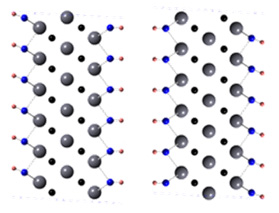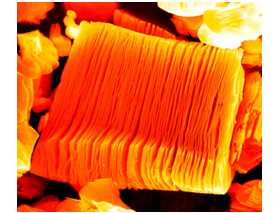MXene- New Family of 2-D Metal Carbides and Nitrides
PHILADELPHIA (August 22, 2011) – An urgent challengecurrently faced by researchers and the public alike is the ability to identify the next generation of sustainable, cost-effective, and energy efficient materials for our everyday use. While searching for new materials for electrical energy storage, a team of Drexel University materials scientists has discovered a new family of two-dimensional compounds proposed to have unique properties that may lead to groundbreaking advances in energy storage technology.
The research team led by Dr. Yury Gogotsi, Distinguished University Professor of Materials Science and Engineering and Director of the A.J. Drexel Nanotechnology Institute and Dr. Michel Barsoum, Grosvenor and Distinguished Professor of Materials Science and Engineering, has recently published a paper titled "Two-Dimensional Nanocrystals Produced by Exfoliation of Ti3AlC2," appearing in the highly prestigious journalAdvanced Materials. In their paper, the research team recounts their ability to transform three dimensional titanium-aluminum carbide, a typical representative of a family of layered ternary carbides called MAX phases, into a two dimensional structure with greatly different properties. MAX phases, known as ductile and machineable ceramics, have been researched by Prof. Barsoum’s lab for more than a decade and dozens of layered carbides, nitrides and carbonitrides with a variety of properties have been synthesized. However, these ceramics have always been produced as 3-dimensional materials.
The Drexel researchers placed titanium-aluminum carbide (Ti3AlC2) powders in hydrofluoric acid at room temperature to selectively remove the aluminum. The result of this chemical process, referred to as exfoliation, essentially spreads-out the layered carbide material and yields two-dimensional Ti3C2nanosheets, which have since been coined MXene, as a kin to graphene. Most notable is that the exfoliated material shows many features of graphene. For example, it can roll into nanotube-like scrolls, some with diameters of less than 40 nanometers (1000 times thinner than a human hair), having the potential for a broad range of applications, ranging from energy storage devices to biomedical applications and composites.
The scientists present their case using an array of experimental techniques and first principles calculations. High-resolution transmission electron microscopy, performed in collaboration with researchers from Sweden, has demonstrated presence of single, double and multilayer sheets with the lateral dimension of several micrometers and thicknesses in the nanometer range. The calculations predict large elastic moduli and an electronic structure that can be tuned by changing the surface chemistry of these sheets.
“Two-dimensional free-standing crystals, such as graphene, boron nitride and metal chalcogenides (for example, molybdenum disulfide), can differ strikingly in properties from their three-dimensional counterparts. Currently, however, there are relatively few such atomically layered materials.” said Michael Naguib, a doctoral candidate and first author of the article.
“Since Ti3AlC2 is a member of the MAX phase family, that to date number over 60, the importance of this study lies far beyond simply the formation of Ti3C2nanosheets. We are not talking about one composition here, but a very large family indeed, thus opening tremendous opportunities in synthesis and application of 2-D materials. This work provides a conceptual leap forward that should lead to a breakthrough in the development of two-dimensional materials.” Gogotsi said.
This work was supported by the Assistant Secretary for Energy Efficiency and Renewable Energy, Office of Vehicle Technologies of the U.S. Department of Energy under Contract No. DE-AC02-05CH11231 – Batteries for Advanced Transportation Technologies (BATT) Program (http://batt.lbl.gov).
Reference:Naguib, M.; Kurtoglu, M.; Presser, V.; Lu, J.; Niu, J.; Heon, M.; Hultman, L.; Gogotsi, Y.; Barsoum, M. W., Two Dimensional Nanocrystals Produced by Exfoliation of Ti3AlC2, Advanced Materials, 2011, http://dx.doi.org/10.1002/adma.201102306

|

|
Schematic of the exfoliated Ti3AlC2 forming two OH-terminated MXene layers
Model – M. Kurtoglu |
Scanning electron micrograph of an exfoliated particle with the size of about 10 micrometers. MXenesheets can be separated by sonication.
SEM – B. Anasori, color – P. Gogotsi |
Source: http://nano.materials.drexel.edu/
Related Items:
Group of american researchers from Drexel University created unique supercapacitors